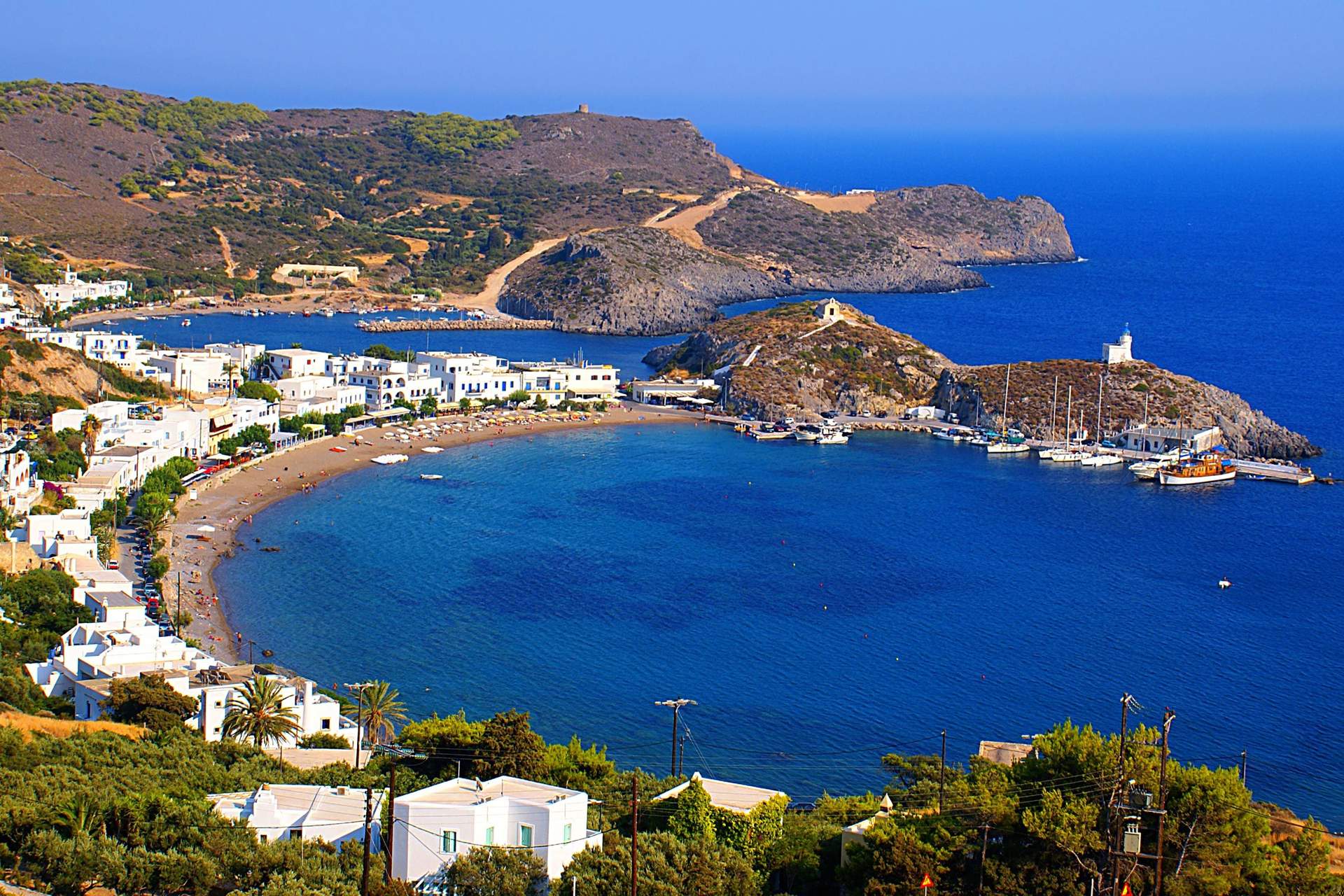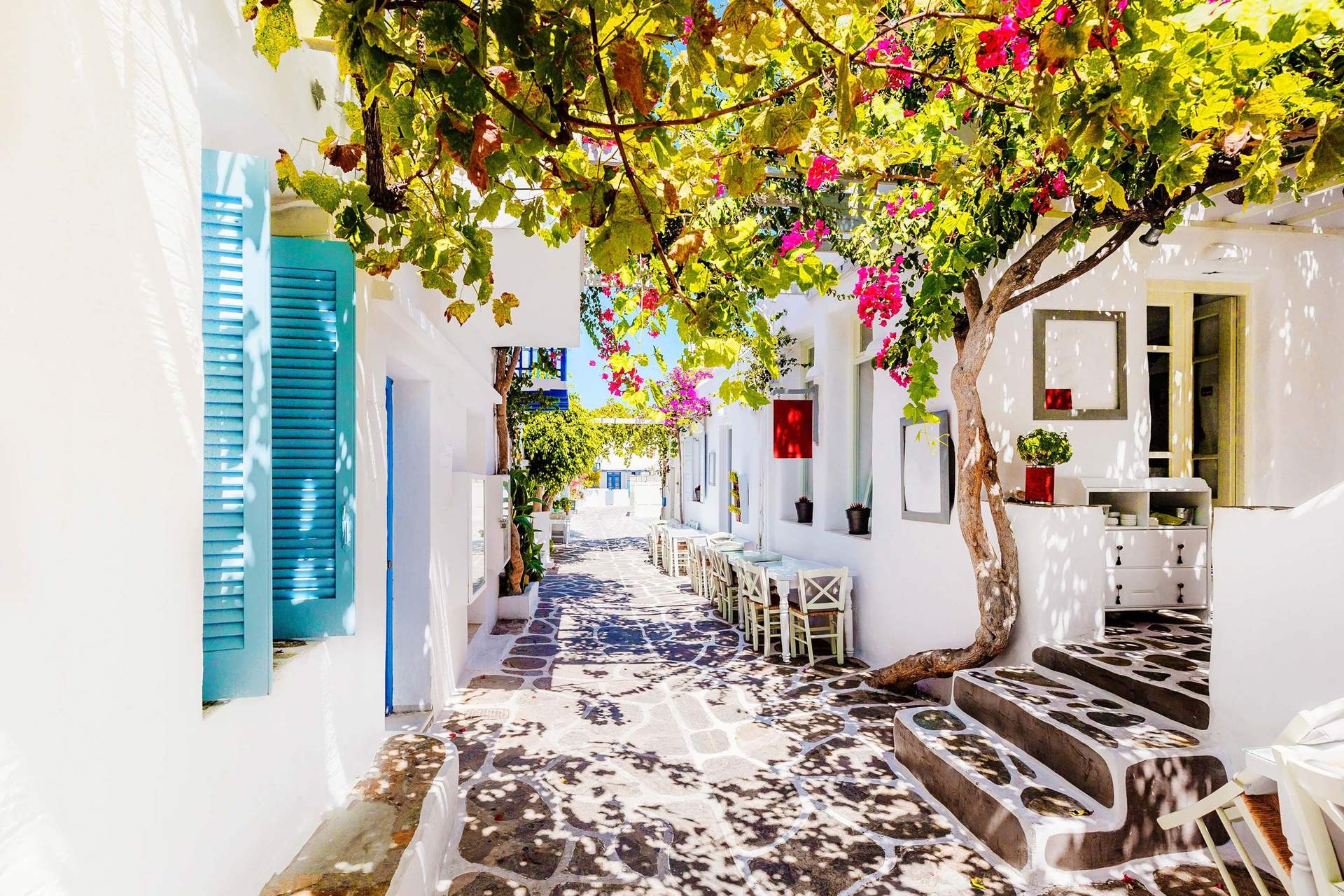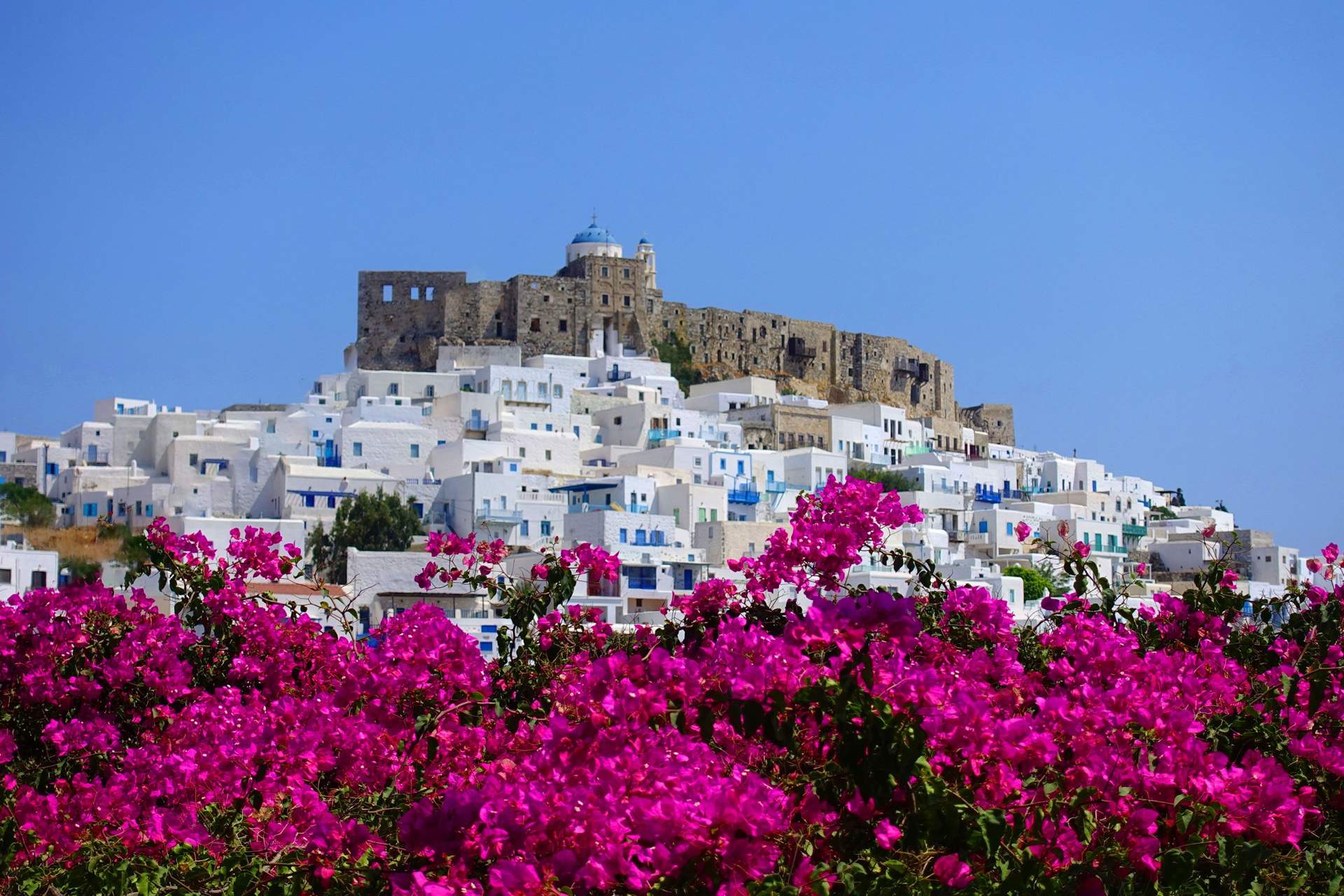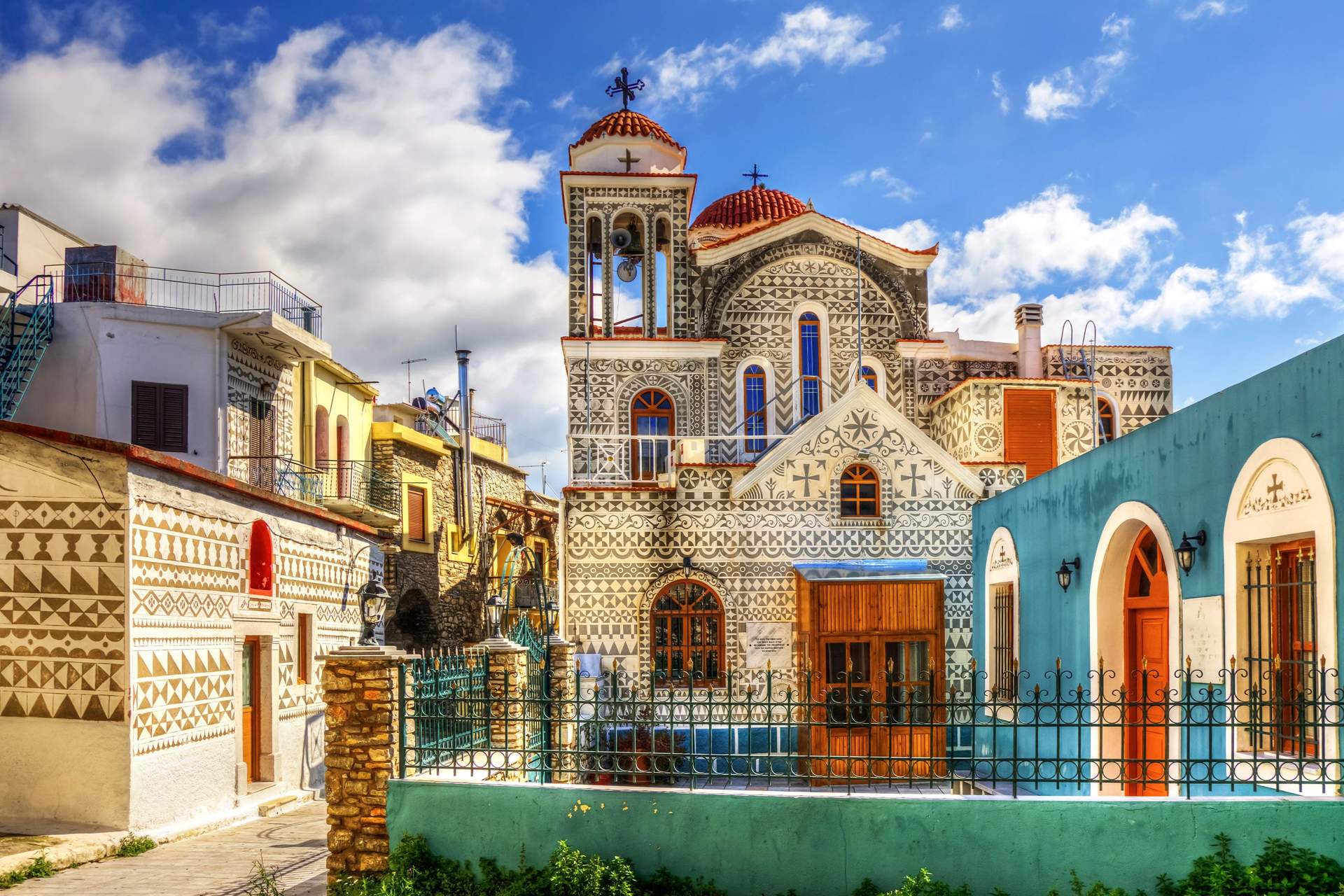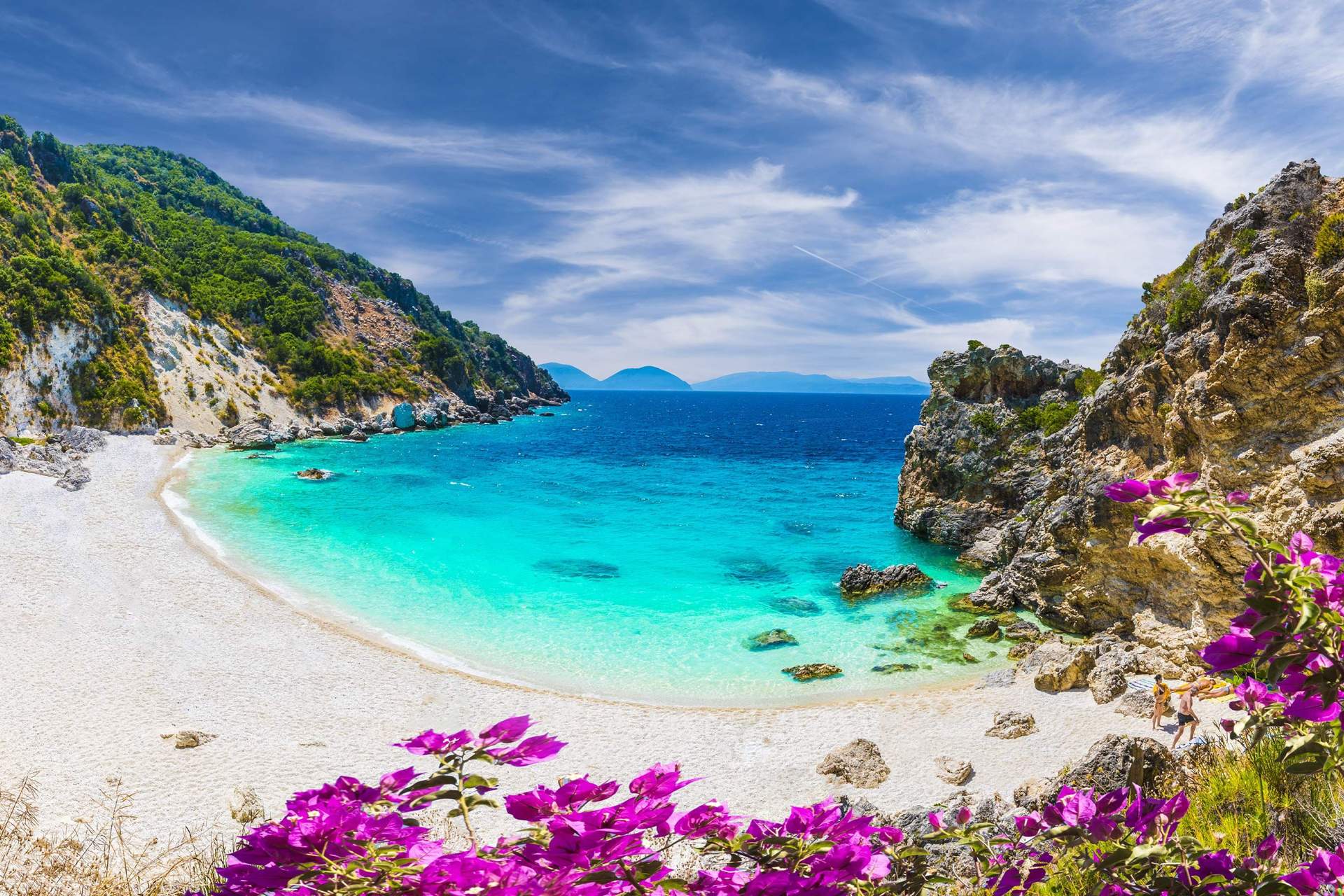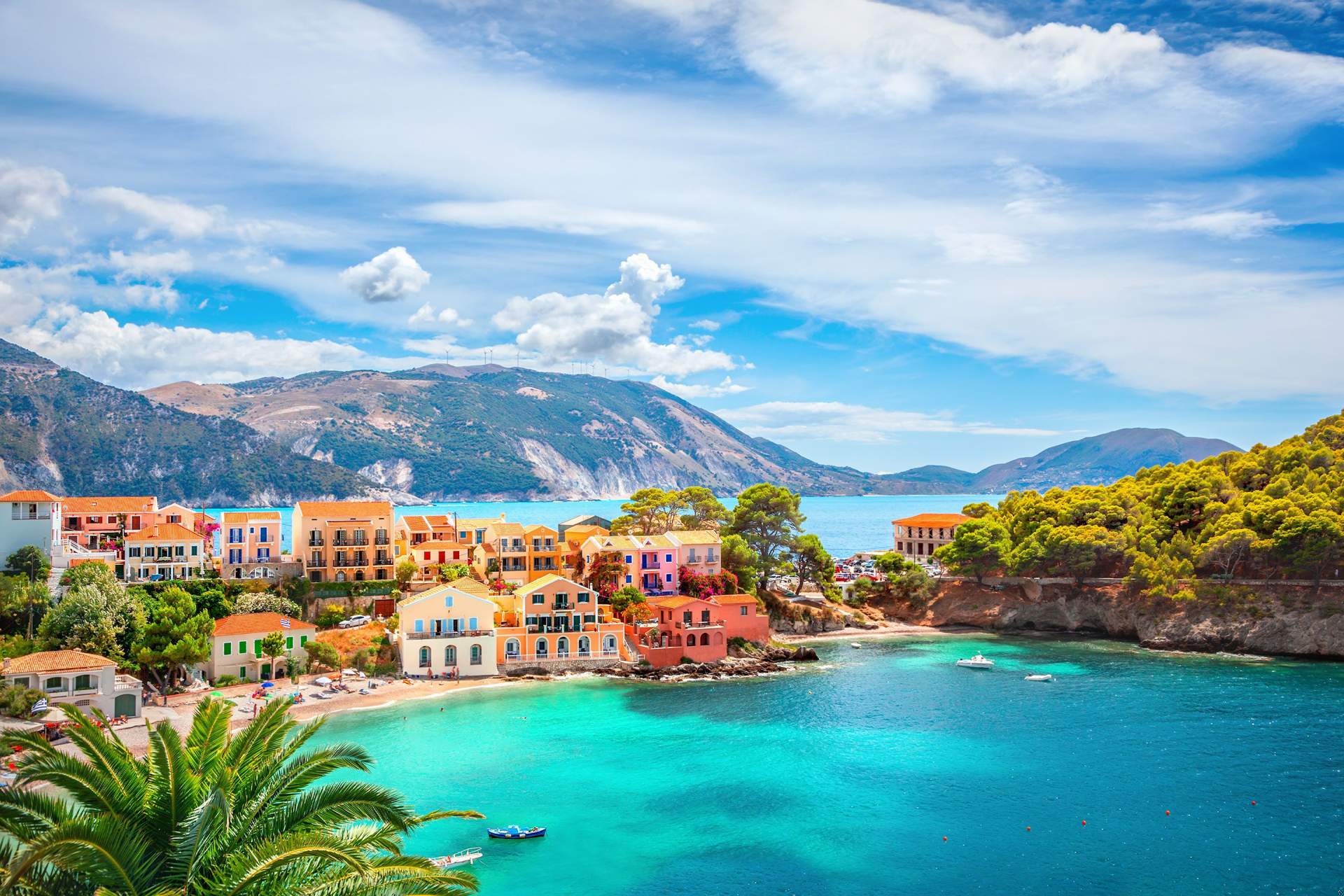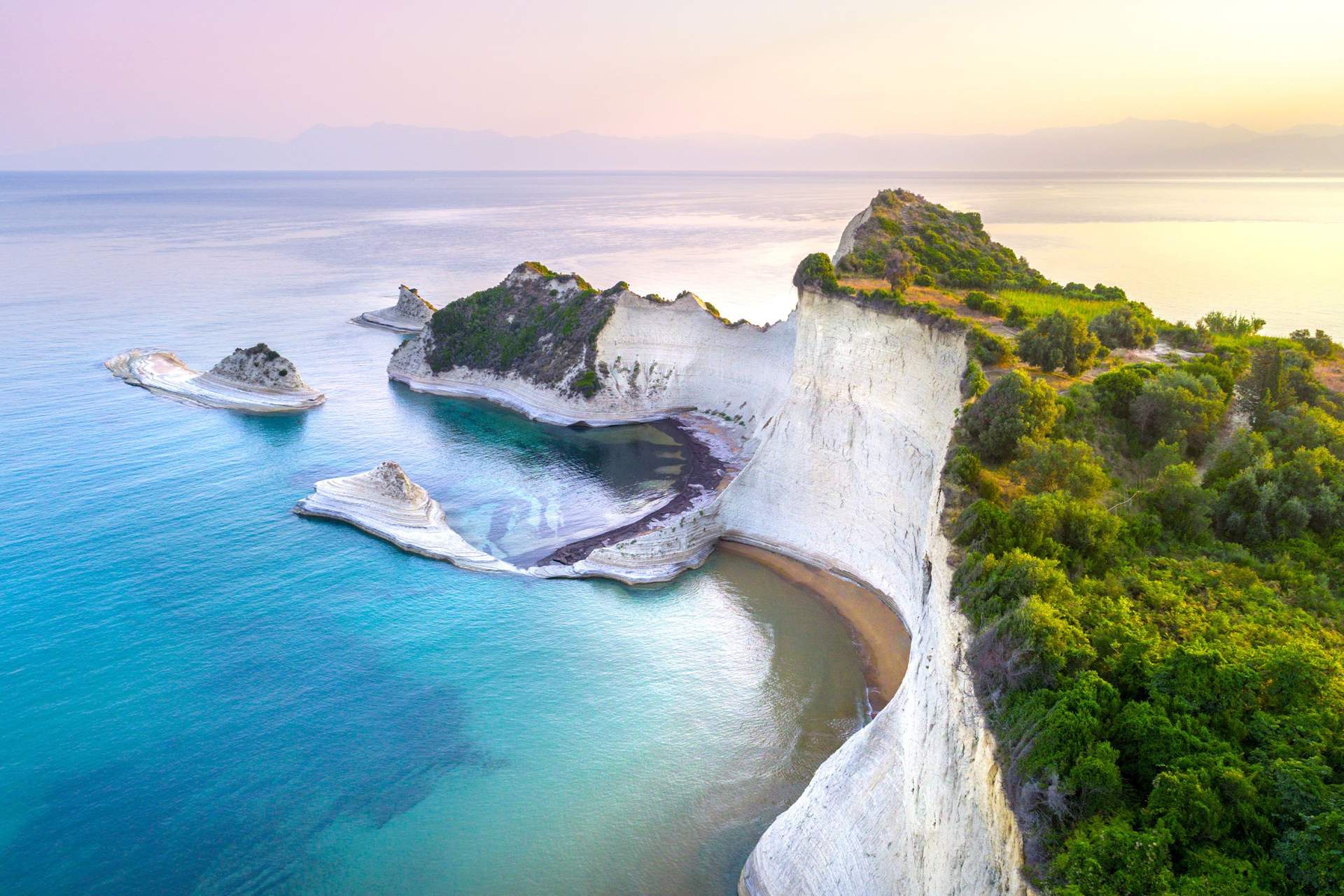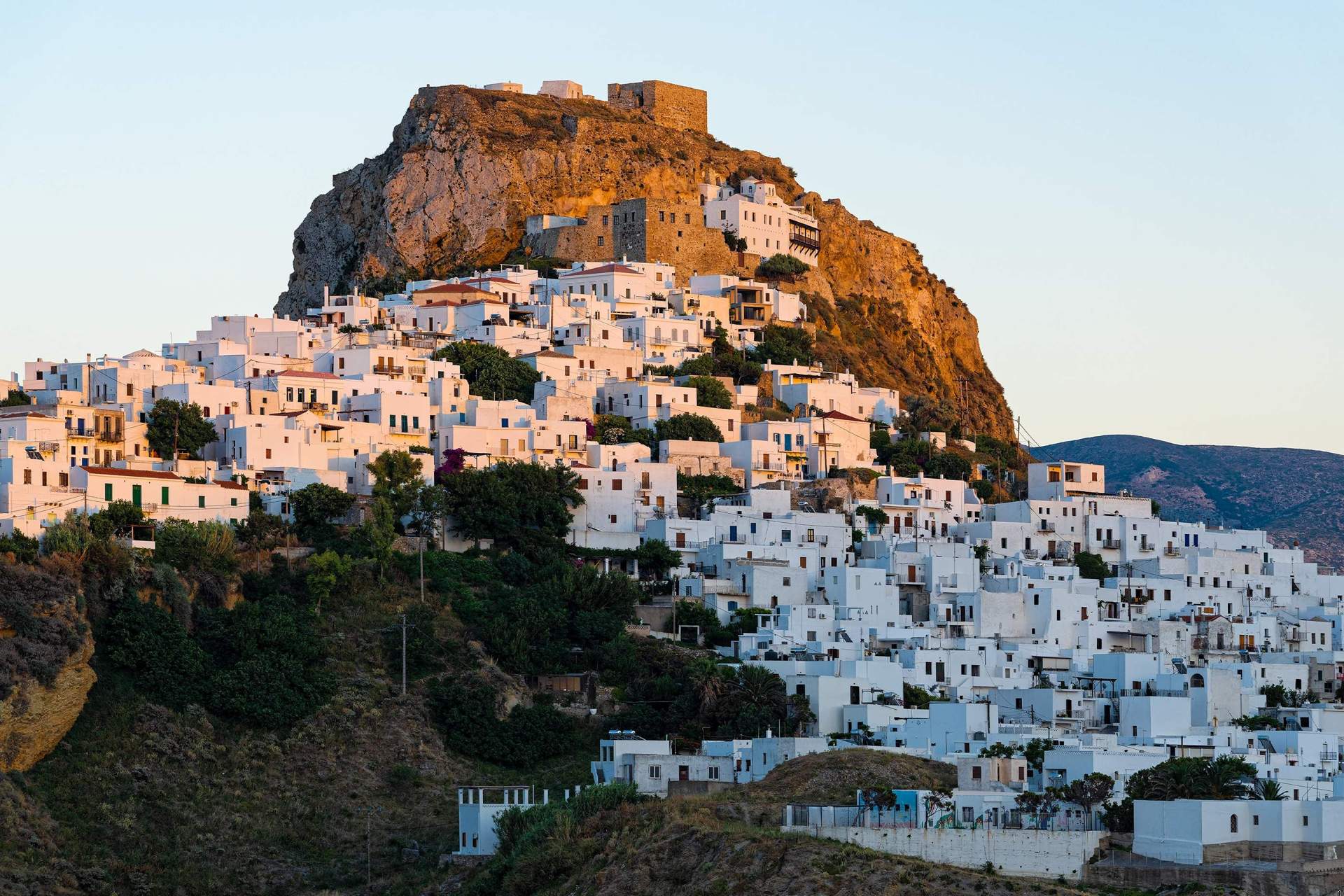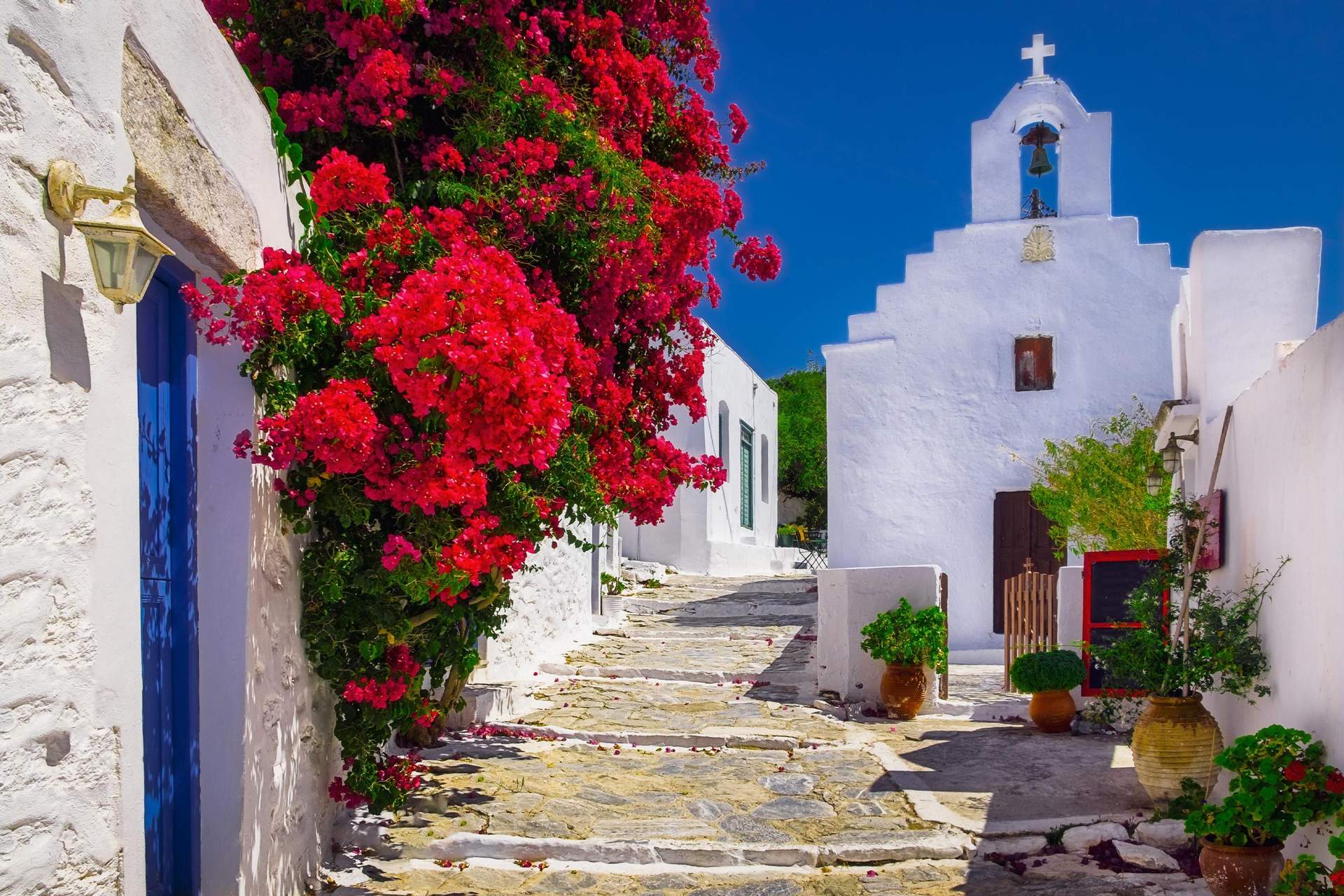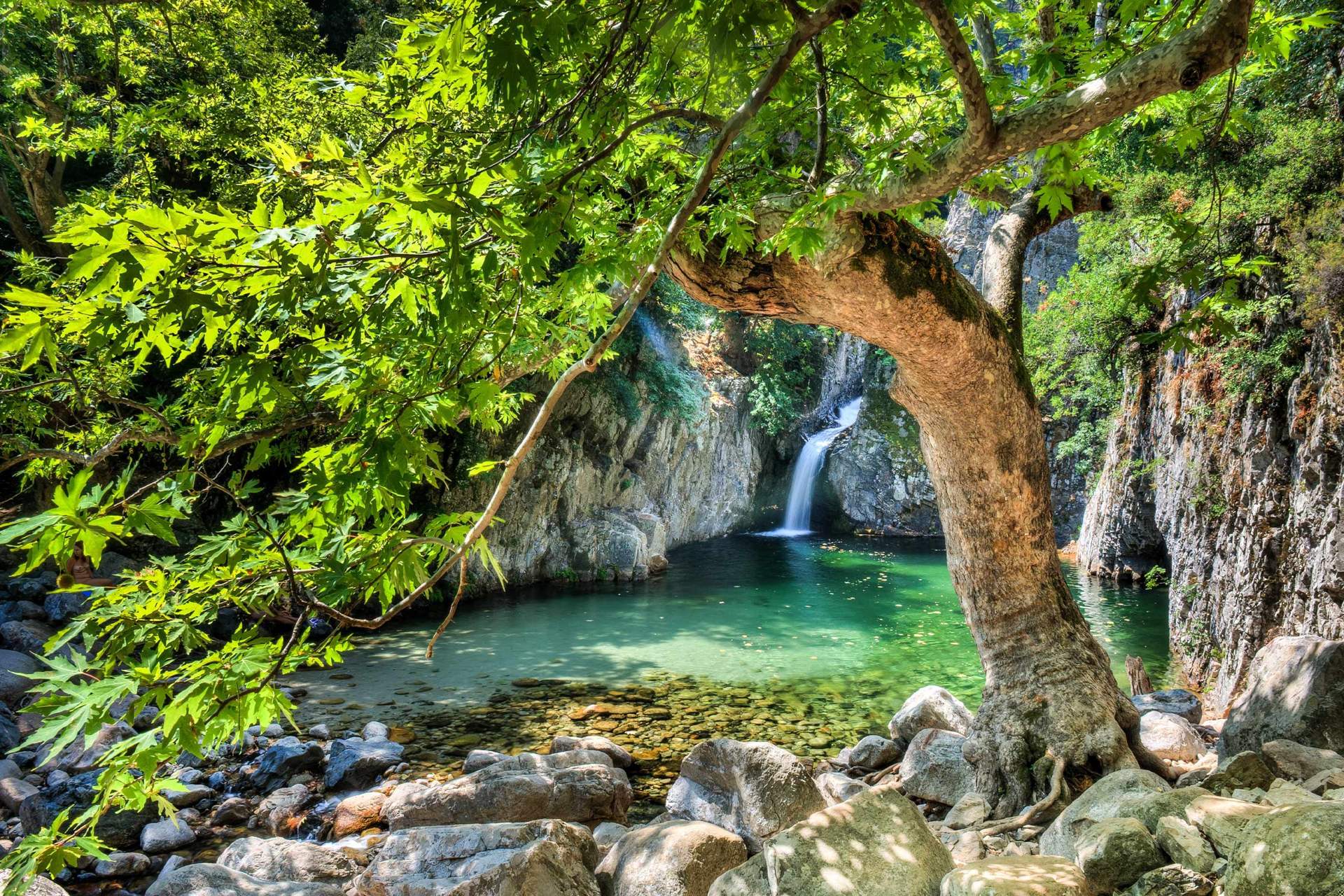Koula was to be my guide to the Athanato Nero – the ‘immortal spring’ – but first she had to milk her goats. We were on Ikaria, famous for its longevity, so it had not been impolite to ask her age: she was 92 – one of the young ones, she laughed, twinkling under her straw hat. The stillness of late afternoon was broken by a loud ‘ping-ping-ping’ as she directed the milk into her tin bucket. It was 6pm, but everyone was still napping; on such a summer night, even small children would be awake until well after midnight.
We were in Xylosirtis, on Ikaria’s less-visited south coast, a village of gardens and apricot trees gazing across the Aegean to Patmos, island of the Apocalypse. Ikaria’s most famous son is, of course, Ikaros (Icarus), who crash landed “just over there,” Koula pointed, as if it had happened yesterday.
The village has a beach, but I had spent the morning braving Ikaria’s vertiginous mountain roads to swim at the spectacular pebble-and-sand beach dubbed ‘Seychelles’, its turquoise water, straight out of the tropics, framed by forbidding granite cliffs and pale grey boulders as wrinkly as elephants. But the long drive back had been tiring; it was time, I decided, to seek the mythical spring.
After Koula finished milking her goats, I followed her down to the sea to the far east-end of the village. The meltemi wind that cools the Aegean was whipping up spray into dancing rainbows. It was all so beautiful that I was startled to see, at the end of the path, the immortal water flowing from a pipe in an ugly cement slab. At least it tasted good. “So is this water why Ikarians live so long?” I asked Koula.
“No – it’s because we never look at clocks!” she laughed. “Besides, we have too much fun to die.”
North Aegean
Samos Island, North Aegean, Greece (Shutterstock)
Ancient history, handsome hilly wanders and Mediterranean culture in Samos, Patmos and Ikaria
Best for: hiking, archaeology, Byzantine art & secrets of longevity
Route: Samos, Patmos and Ikaria
Why? To explore World Heritage sites, hike lush mountains and laze on unspoiled beaches.
How? Fly to Samos from London or via Athens, then take a ferry to Patmos (1.5 hours) from Pithagorio, the port nearest Samos airport. Back on Samos, hire a car that you can drop off at Karlovasi port. Take a ferry to Ikaria (from 1 hour), hire another car, then fly back from Ikaria via Athens.
The unlikely location where the exiled St John dreamed of the Apocalypse and wrote the Book of Revelation, little Patmos still has a numinous, otherworldly feel unlike any other Greek island. This is partly because it’s just too rugged to build an airport on, although it’s only a short ferry hop of just over 90 minutes from Samos.
As you pull into the island’s main port, Skala, the fortress Monastery of St John the Theologian looms above you, skirted by the evocative, silent, pure-white old town Chora. Founded in 1088 by the blessed Christodoulos and paid for by Byzantine emperor Alexios I Komnenos, the monastery was one of the richest and most powerful in Greece, with a wealth of frescoes and treasures displayed in a series of intricate, intimate rooms. Just beneath is the Cave and Monastery of the Apocalypse, complete with St John’s rock pillow. Together with the Chora, the two monasteries are designated a UNESCO World Heritage site.
Wander Chora’s narrow, flagstone-paved maze of lanes (designed to confuse pirates), lined with mansions built by sea captains and merchants; the freedom to trade was inscribed in the monastery’s charter. If any of its 40-odd churches are open, pop in to see their lavish interiors, the result of local families competing to out-endow one another. A row of picturesque windmills, three of which have been restored, stretch over the ridge above; access them via the path from the Monastery of the Apocalypse.
The other thing to do, especially if cruise ships have disgorged their hordes in Skala, is wander; trails radiate out from Kambos to the north, the only other real village of Patmos, where each step reveals a different vista across its jigsaw-puzzle coast. Aim for one of the island’s peaceful beaches: Lambi (‘the shining’), among the prettiest, has glistening multi-coloured pebbles. And relish the stillness before heading back to Pithagorio and Samos.
Conveniently for visitors, the airport on the south-east coast is near the island’s UNESCO World Heritage site: the sixth-century-BC Heraion, commemorating the birthplace of Hera, goddess of marriage. Possibly the largest temple ever built in Greece, it’s now a glorious ruin, as is the monumental Sacred Way linking it to the ancient city of Samos. Ancient Samos was re-named Pithagorio after hometown mathematician and philosopher Pythagoras, he of the famous theorem. Pythagoras may have lived to see its other marvel: the 1,036m Tunnel of Eupalinos, a secret aqueduct begun around 550BC. The engineer Eupalinos had slaves dig with mathematical precision from both ends, then rewarded the survivors with freedom for a job well done. It’s a marvel to walk through – if you aren’t claustrophobic.
There’s an excellent archaeological museum in Pithagorio, and an even better one in the capital, Vathy, 11km to the north, starring an extraordinary 5.25m kouros statue, dating from 580BC and excavated on the Sacred Way, wearing the Buddha-like smile described by John Fowles as “having known divinity”. Some of the island’s best beaches are west of Vathy around Kokkari, a pretty resort with a picturesque curl of pebbles on an isthmus; Avlakia makes for a quieter alternative, while Agios Konstantinos farther west is backed by a thick plane tree forest.
Samos’s ancient nickname was the ‘Isle of the Blessed’; to see why, climb above Agios Konstantinos to the bucolic spring-fed woodlands on 1,153m Mount Karvounis, famous for nightingales and botanical diversity. Many of Samos’s 1,530 native plants grow here; of all the Greek islands, only Crete has more. Ancient donkey paths link the attractive mountain villages of Manolates, Vourliotes, Stavrinides and Ambelos (for maps, see Samos Hikes).
Just beyond the western port of Karlovasi, take in one more beauty spot: Potami Beach, starting point for an idyllic walk to three splashing waterfalls and a taverna. Bring swim shoes and wade upstream through a ravine lined with ancient trees. It’s three hours by ferry from Karlovasi to Ikaria’s south-coast capital, Agios Kirykos, or a 75-minute ride to Evdilos on the north coast, where you’ll find most of the hotels; a ring road linking the two crosses the Aetheras mountains, rising to 1,037m.
But the first thing to do on Ikaria is ask where the next panegyri (saint’s day festival) is happening: the island’s villages are famous across Greece for their Dionysian feasts of wild goat and wine, with music and dancing until dawn.
Besides beautiful ‘Seychelles’ beach in the south, swimming spots include hot springs bubbling in the sea at Lefkada near Agios Kirykos. In the north, you’ll find rarely crowded beaches around Armenistis, Gialiskari and Nas, backed by the mighty foundations of a Temple of Artemis. A dramatic trail leads up from Nas through boulders and woods to Christo Raches, a dreamy Brigadoon of a village, famously run on ‘Ikaria time’, where people take the longest naps and stay up all night.
Secret Cyclades
Andros, Cyclades, Greece (Shutterstock)
Wander tempting trails amid the classical sites and varied scenery of Andros, Tinos and Syros
Best for: hiking, architecture and culture
Route: Andros, Tinos and Syros
Why? To explore the beauty and culture of three wildly diverse, lesser-known Cycladic islands.
How? From Athens airport, take the bus to Rafina port then the ferry to Andros, and hire a car. Ferries sail frequently to Tinos and Syros (get around by bus or taxi on both islands); from Syros, fly to Athens or sail to its port, Piraeus.
Northernmost of the Cyclades, Andros is a cradle of Greek shipping dynasties. Many are based in London (hence the island’s nickname, ‘Little England’) and have Neoclassical mansions in the island’s capital, Chora; it looks like no other town in Greece, piled on a narrow peninsula with a snazzy Museum of Contemporary Art, a ruined castle at the tip, and a lighthouse isolated on a sea rock like a wizard’s tower in a fantasy novel.
South of Chora, walk up from Kochilos to the Old Lady’s Castle, with views over the Aegean. Below lies Tis Grias to Pidima (‘Old Lady’s Leap’), Andros’s most-photographed beach, a wild sandy cove beneath a towering 15m pinnacle in the sea, reached by a steep path; legend has it that the rock is an old lady who betrayed the castle to the Ottomans and leapt to her death in remorse. On the west coast near Zaganiaris is Neolithic Strofilas, the remains of the earliest known city in Europe. The ruins, dating back to 4500BC and spanning 12 hectares, feature defensive works and engravings of ships and animals.
But Andros is, above all, great for walking; in 2015 it became the first island recognised by the European Ramblers Association for its volunteer-maintained footpaths, including the 100km Andros Route. These traverse four mountain ranges, densely wooded hills and villages lush with springs and waterfalls, citrus groves and cypress trees. From the island’s western port of Gavrio, you can hike up to the Hellenistic tower of Agios Petros; alternatively, make the dramatic descent from the lofty village of Vourkoti (620m) to Achla Beach or to Arni, Andros’s ‘little Switzerland’.
A 90-minute ferry ride to Tinos will drop you just below one of Greece’s most-beloved pilgrimage sites: Tinos Town’s elegant Evangelistria church, housing the miracle-working, gem-laden icon of the Virgin. The pious walk there on their knees, especially on the Virgin’s holidays, 25 March and 15 August, when Tinos is busy.
But Tinos is also an island of magical walks, especially north of Tinos Town around 640m Exombourgo, once site of a Venetian fortress that defied the Ottoman armies for over two centuries until 1715; a path leads up from Xinara. Other treks wind past a thousand pretty white dovecotes (the finest are in Tarambados) and Volax, a tiny village immersed in a surreal landscape of granite boulders.
In Tinos’s wild, wind-whipped north, the village of Pyrgos is built almost entirely of gleaming marble. Along with a Museum of Marble Crafts, it has a sculpting school whose students are currently restoring the Parthenon. Below, Panormos has fine seafood tavernas and a beach in the tamarisks.
It’s a short hop from Tinos to Syros for something completely different. Ermoupoli, Neoclassical capital of the Cyclades, is piled on twin hills, one Orthodox (Vrondado), one Catholic (Ano Syros); the latter is older and maze-like, with wonderful traditional ouzeries. City buses run there.
A vital coaling station for steamships, Ermoupoli once powered the economy of the newly independent Greece – hence its lavish seaside mansions, Greece’s first opera theatre, and marble paved Miaoulis Square, with its palatial town hall housing a good archaeology museum; there’s even an El Greco in the Church of the Dormition. Buses go to the beaches: Kini has sand and sunsets.
Little Dodecanese
Nisyros Island, Dodecanese, Greece (Shutterstock)
Discover multi-hued hillside towns, volcanic craters and grottoes at the edge of the Aegean
Best for: architecture, unspoiled landscapes, and a volcano
Route: Symi, Tilos and Nisyros
Why? Explore a remarkable town, view mini elephant fossils and walk on a crater.
How? From the UK, fly to Rhodes and return from Kos; frequent sea links connect all three islands.
Arid Symi looks unpromising until the ferry turns into its harbour, when passengers emit gasps of wonder as a sky-high amphitheatre of colourful Neoclassical houses heaves into view. Nicknamed ‘Greece’s Portofino’, its step-filled lanes lead to pretty pebble mosaic courtyards, cosmopolitan bars and restaurants, an excellent history museum and, 500 steps up, the ruined castle of the Knights of St John, providing eye-popping views.
Taxi boats and buses go to the beaches, including nearby Pedi and, a little farther south, Agios Georgios Bay, sitting beneath 300m cliffs. Continue to the island’s southern tip to visit the Venetian Baroque Monastery of Archangel Michael Panormitis, patron of Greek sailors, with the biggest pebble mosaics and a peaceful beach.
Next, sail to tranquil Tilos, Greece’s star eco-island. In 1993, the mayor banned hunting; now it’s an energy- self-sufficient wildlife reserve, home to Bonelli’s eagles and Eleonora’s falcons. The port town, Livadi, is barely one street deep, while the main town, Megalo Chorio, is only slightly bigger; its Paleontological Collection of Tilos is worth visiting for its displays of ancient pygmy elephant fossils discovered in a cave on the island. Hike to ruined castles and to the ghost village of Mikro Chorio, and forget the rest of the world while relaxing on the beaches.
The third little island, Nisyros, is a volcano. Ferries dock in its bijou port, Mandraki, overlooked by the 3,000-year old walls of its Mycenaean acropolis; close by is Chochlaki beach, made of shiny black pebbles.
Nisyros’ green landscapes grow increasingly dramatic and lunar as the island bus from Mandraki ascends the caldera. Thermal vents steam and stink; you can stroll on the solid crust of enormous Stefanos crater, but wear thick-soled shoes. Don’t miss the opportunity to take the spectacular walk around the caldera’s rim to the villages clinging to its edge: Nikia (with Greece’s only Volcanology Museum) and Emborios.
If the other little Dodecanese seem too busy, there’s always Kastellorizo. Tucked under the south coast of Turkey – five hours from Rhodes by ferry, or 40 minutes by air – Kastellorizo is by any measure the most remote inhabited island in Greece. Long forgotten, it did a star turn in the 1991 Oscar-winner Mediterraneo, and in David Gilmour’s soulful ‘Castellorizon’ from his album On an Island. These days it attracts passing yachts, a sprinkling of Italian film and Pink Floyd fans, and anyone seeking that special end-of-the-world feeling.
Kastellorizo’s car-free (and only) town of colour-drenched Neoclassical houses is huddled around the waterfront. Incredibly, a century ago some 15,000 people lived here; during the 20th century, after the worst streak of bad luck suffered by any Greek island – including a mass evacuation and fire during the Second World War – only five families remained. Most of the others emigrated to Australia. Today the population hovers around 500.
What to do? It’s one of those places to be, rather than to see – to turn off your phone, to wander and breathe in the warm scent of oregano and sage, to daydream by the gentle lapping of the sea. But you can take in two small museums of archaeology and folklore (the latter housed in the Ottoman mosque). Have a look at the Lycian tomb from the fourth century BC, its temple façade cut into the living rock, and take the walk up to the medieval castle of the Knights of St John, where misbehaving knights from Rhodes were sent to cool their heels.
Locals offer boat trips to the Blue Grotto – like that at Capri – where the walls are bathed in blue by the light refracted through the very low entrance. It’s at its most arresting in the morning when the sea is calm – you’ll need to lie flat in the boat to slip in, but the reward is an unforgettable chance to swim amid the shimmering iridescence. Kastellorizo is one of the very few Greek islands without a single beach, but do as the locals do and dive into the crystal-clear water off the rocks or platforms in town, with useful ladders to help you get back out. After your afternoon nap, walk up to the Monastery of Agios Georgios for the view over Kastellorizo and its clutch of baby islets, Turkey’s dramatic Lycian coast, and the empty horizons beyond.
Central Sporades
Skopelos island, Sporades, Greece (Shutterstock)
Historic monasteries, Marine Parks and sunset-view tavernas beckon from blue-green isles
Best for diving, immaculate beaches and serenity
Route: Skopelos and Alonissos
Why? To walk in lovely landscapes unwind on the beach and explore the National Marine Park.
How? Fly into Skiathos, then take the ferry or hydrofoil.
The Hollywood blockbuster musical Mamma Mia! may have put ruggedly beautiful Skopelos on the map – but now, after all the hoo-ha, the island’s fragrant pinewoods, pebble beaches and sapphire seas have rediscovered their old tranquillity. Skopelos Town’s churches and castle are charming examples of traditional architecture, and its tavernas are renowned for cheese pies and rembetiko (Greek blues) music.
A path links a string of monasteries on Palouki, the mountain that dominates the port. Now mostly abandoned, some resemble little castles; all have breathtaking views.
From Glossa, Skopelos’s other town perched over the sea, you can hike or taxi to wild east-coast beaches including the gorgeous strand beneath Agios Ioannis Kastri, the Mamma Mia! wedding church high on a rocky outcrop.
Just east of Skopelos, peaceful rustic Alonissos is the only inhabited island in Europe’s largest (2,260 sq km) National Marine Park. Blue Flag beaches here are rarely crowded, and Eleonora’s falcons and eagles float overhead.
The Alonissos Museum in the southern port of Patitiri has art and relics of pirate days. The old capital, Chora, offers lovely sunset views from its tavernas. But the National Marine Park of Alonissos and Northern Sporades is the main draw: created in 1992, more than 300 species of sea creatures thrive here, notably the highly endangered Mediterranean monk seal that hauls out on off-limit islets. A rescue centre in Steni Vala on Alonissos’ east coast cares for injured seals.
Local boats offer outings to the accessible islets including Kyra Panagia, with its 17th-century monastery. Peristera has fine beaches and Greece’s first Underwater Museum, offering divers a chance to explore the massive ‘Parthenon of Shipwrecks’ that went down with 4,000 amphorae in 425BC. Four other shipwrecks will be added, a great incentive to learn to scuba; dive schools on Alonissos offer lessons.
Footnotes
Food & drinkGreeks dine late, especially in the summer. Lunch at 2pm and dinner at 10pm is not unusual, with plenty of snacks and drinks (and ideally a nap) in between, but the islands are used to catering to visitors, and tavernas and restaurants open by 8pm. You’ll find lots of seafood, salads, savoury pies, grilled meats, yogurt dishes, baked vegetable dishes and breads. Do as the Greeks do: order lots ofmezedes(small plates) and try as many as possible. Greek wines get better every year, along with evergreen favourites such asouzoandraki.
Getting there & aroundRegular flights from the UK serve Athens and the most popular islands, taking 3-4 hours.Aegean Air has connections to smaller islands, mostly from Athens and Thessaloniki;Sky Expressflies between various islands. In summer, book sea journeys in advance atDirect Ferriesorgo-Ferry. A slow ferry (eg Tinos to Syros) takes an hour. On larger islands, you’ll probably want a car; book one at the same time as your flight to avoid disappointment.
Read more about Greece








































































































